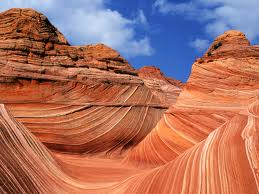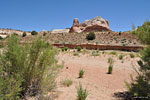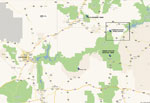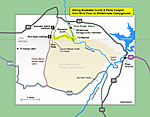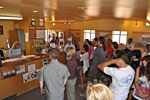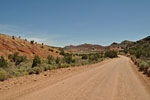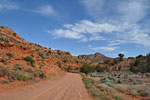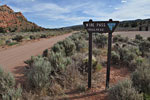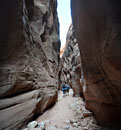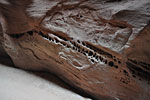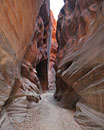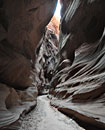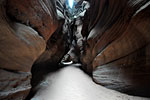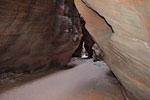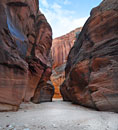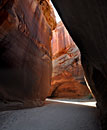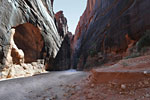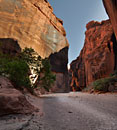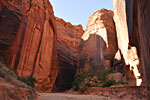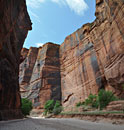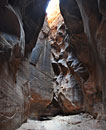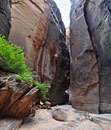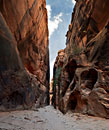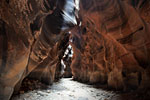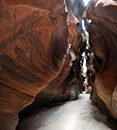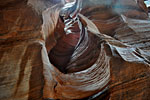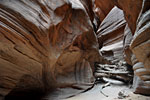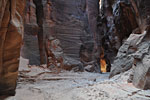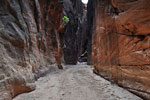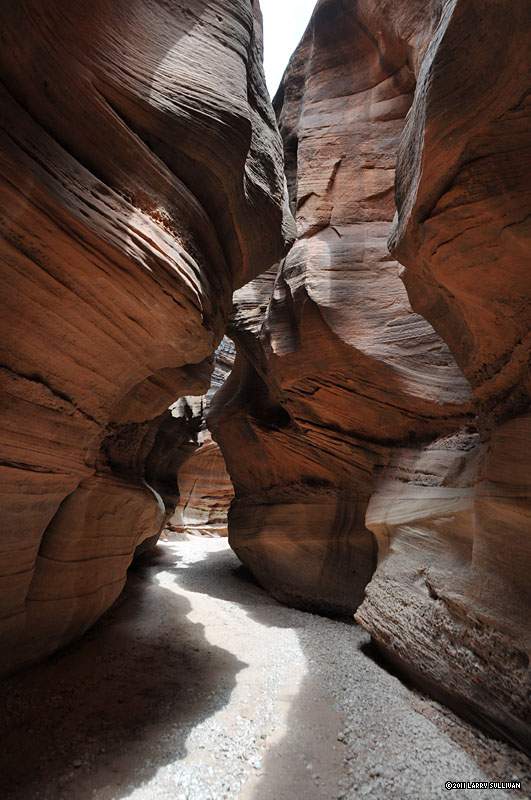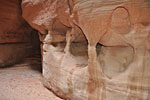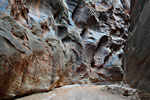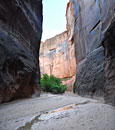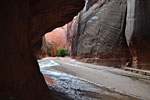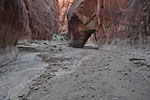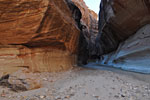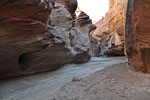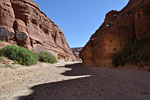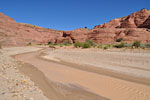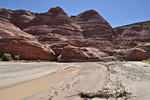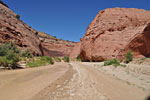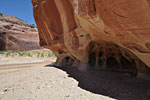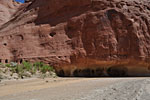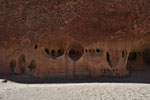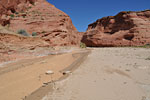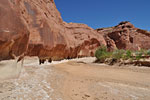 |
|
| Buckskin Gulch & Paria Canyon, Paria Canyon-Vermilion Cliffs Wilderness, Utah & Arizona A 21 mile adventure through deep slot canyons and alien landscapes |
Picture traveling an entire day through the hot desert wilderness, but hundreds of feet below the surface in a cool subterranean passage. The light filtering in from high above highlights the sandy path and paints the wavy walls yellow, orange, red and blue. The echo of your voice rings down the corridor - there's no one else around for miles! Deep in the expansive wilderness of southern Utah and northern Arizona, Buckskin Gulch and Paria Canyon is the longest continuous slot canyon in the world. This area is in good company for dramatic geologic exhibitionism, situated as it is 100 miles north of the Grand Canyon. The fact that most have never heard of it is not a bad thing to those who've been there. Once you hike it, you almost don't want to reveal the magic to others. But this place is big enough that you can feel like you don't have to share it. |
Wire Pass Wire Pass is the name given to a shortcut canyon to Buckskin Gulch. It's a brief but interesting non-technical slot canyon of its own, a sandy path between high warped walls in flickering sunlight. Wire Pass trail starts in a wash at House Rock Valley road, and ends 3 miles later when it joins Buckskin Gulch. It's dry most of the year and is popular as a family dayhike, but there are some flood debris obstacles to scramble over and under. Wire Pass is noteworthy as the trailhead to reach the Wave. A permit is required at all times here. The Wave
Paria Ranger station There's a lot of big open space, and not much civilization out in this part of southern Utah, so the Paria Ranger Station on Hwy. 89 is one of the few stopping points. The Park Service calls this the Paria Contact Station, as it functions as a visitor center where you can buy maps and posters, as well as issue permits for hiking in Wire Pass and Buckskin Gulch. They also have tapped a spring, and have lots of fresh drinking water. |
After a week of canyoneering in Zion National Park, I drive east into the vast desert above the Grand Canyon to explore Buckskin Gulch and Paria Canyon. I learned of this area after seeing images of the Wave, the curvy rocks so popular with photographers. I got my permit for a June overnight hike in Paria Canyon back in March, but I'd hoped to score a walk-in permit to The Wave at the daily lottery too. This hike requires a shuttle between trailheads. The end is 15 road miles from the beginning. There are several local residents who will shuttle hikers for $75pp and up (2011). I saw 6 backpackers climb into a shuttlers van at Whitehouse Campground - 6 times $75 is a pretty good profit for driving 30 miles. But then again, I don't think I'd want to live way out here either. But I don't like to pay for rides as a matter of principle, so I'd left an extra day in my schedule to work out the logistics of leaving my car at the exit trailhead and finding my way to the entry. In my experience, when you're doing a car shuttle hike, it's better to leave the car at the end of the hike, rather than the beginning. Not only is there the psychological bonus of finishing your hike at your "home" on wheels, (and a cooler of drinks), but you have a better chance to catch a ride with ordinary folk at the beginning of your hike when you're less trailish looking. After enduring the excited crowds at The Wave lottery at the Paria Ranger Station in the morning without scoring a Wave permit, I drive up to House Rock Valley Rd., the long dirt road out to the Wire Pass trailhead. I want to scope out the trek I'm about to make and the trailhead camping situation. Also, I don't want to haul a bunch of water if I don't have to. There's a tapped spring at the Ranger Station and lots of fresh cold water. There's none at the trailhead. House Rock Valley Rd. is dirt and rock, regularly graded and seems well-maintained, although I've heard that rains make it muddy and impassible. A ranger told me on the phone that many people get flat tires and to check your spare, but I found only a few rough spots on this beautiful dry morning. The countryside is very scenic - an undeveloped landscape of rolling hills with red rock outcroppings, and a few pastures. |
About 5 mi. from Hwy. 89 south on House Rock Valley Rd. is the first trailhead, Buckskin Gulch, the actual beginning of the canyon. Several miles later - about 8 miles from the highway - is the Wire Pass trailhead, a shortcut to the Gulch, where theres a large dirt/gravel lot and 2 new toilets. It's very hot! I set up my tent and stash my overnight gear and lots of extra water. I then retrace my route, driving 15 miles back up House Rock Valley Rd., back east on Hwy. 89, past the Ranger Station to the Paria River trail's exit at White House campground, where I leave my car. Now I'll hike the 15 miles back to the start, as it were. Hopefully, I'll find a ride though... After a 2 mile walk from White House campground past the Ranger Station to the main highway, I was lucky enough to cross paths with a photographer and his wife returning to their car at the Ranger Station from a photo trip to the hoodoo's nearby. They offered me a ride to House Rock Valley Road, going the wrong direction out of their way, eliminating the one bad leg of the hike I wasn't looking forward to - walking for 5 miles on the shoulder of the busy 2 lane blacktop. After profuse thank-you's (no they wouldn't take $20 to drive me 8 mi. more to the trailhead, but I had to ask...) I start walking down House Rock Valley Road in the hot mid-day sun. All my gear for the overnight hike waits for me 8 miles ahead in my tent, so I'm hauling an easy load of much more water than I need and snacks. At first, I plan on sticking out my thumb while walking, but this is a dirt wilderness road in the desert mountains and not one car passes in my direction for the next 4 hours. Nevertheless, after 2 miles in, I decide not to hitchhike regardless, and will make it to the trailhead on my own - this is a hike I'm going on anyway right? The scenery is nice, I have plenty of water and time, take an enjoyable break under an old shade tree. It turns out to be a fine hike, good preparation for the following 2 days in Buckskin Gulch and Paria Canyon. |
| Day 1: Wire Pass to Buckskin Gulch | |||
|
| Day 2: The Confluence, Pariah River, White House campground | |||
|
| Hiking from Wire Pass through Buckskin Gulch and Paria Canyon to White house campground
The Gulch is mostly an easy-to-walk sandy path, with no drop-offs and technical climbing. Most of it is in the shade and there is no noticeable elevation gain or loss, but there are a few landslide boulders and obstacles to climb over, under and around. The beginning of the hike is 15 miles from the end by car and road, and 21 miles by canyon hiking. Typically, the 13 miles from Wire Pass to the Paria confluence is day one. 2 days camping is allowed, but there's little water, so day two usually means either turning up north and out the Paria in 8 miles at White House campground, or east down the Paria for 26 miles to Lee's Ferry. (Or backtracking the way you came in). Logistics Those doing this hike with only one car can expect to pay $75 per person (2010) for a local resident with a truck to shuttle them the 15 miles from White House Campground, the trails exit where they leave their car, to the Wire Pass trailhead. The shuttle drivers require 24 hour notice. You can get the current contact info from the Ranger Station listed below. Or, if you have time, like I did, you can hike it. There are two trails from which to enter Buckskin Gulch - the beginning at mile 5 of House Rock Rd., or from Wire Pass trailhead, at mile 8. Wire Pass is also the trailhead to visit the highly regulated Wave, through a nondescript opening on the right about 1 mile in. Wire Pass trailhead is 8 miles south of Highway 89 down House Rock Valley Road, a wide dirt road through the desert wilderness. This road is said to be impassable when wet and a 4WD vehicle is suggested by the park service, who also recommended having a good spare tire available. I got good beta from a recent visitor, and found it well-graded, wide and no problem for my 2WD sedan on this dry, mid-June trip. Overnight camping is allowed at the large parking lot, with more space above it, and there are 2 toilets. It gets very windy here and the dust gets flying. The trailhead is across the road from the parking lot. |
Camping The Park Service has clean, free camping at the White House campground, which has 15 tent spots with benches and grills, some with shade, and 2 new toilets. The campground is 2 miles down a gravel road from the entrance, which is just before the Ranger Station. You might want to stake your tent fully here, as strong gusts thrash through the prairie each morning. The Paria River trail starts behind the toilets at the White House Campground. No permit is necessary to dayhike here. The trail is the river bed, so shoes that don't fill up with water are helpful. Whitehouse rock is within 1 mile, the hobbit houses, 3 miles, and the confluence with Buckskin Gulch, 8 miles. Additional free camping is available at Stateline Campground, 2 miles south of Wire Pass on House Rock Valley road. There are a few places to set up a tent at the Wire Pass trailhead, but it's mostly just a large, gravel parking lot on the House Rock Valley road, by a wash with no shade. There are new toilets. Some people overnight in their cars or RV's. There is a private campground west of the Ranger Station on Highway 89 with showers and RV hookups. Safety Hikers should plan on packing in all their water. At least one gallon per day is recommended. There is no water available for drinking until a spring 3 miles beyond the confluence, which is 13 mi. from Wire Pass trailhead. Slot canyons are potentially extremely dangerous places to be when it rains. A flash flood can sweep through before you can escape. Many people have lost their lives in slot canyons due to rapidly changing weather conditions. Even if the weather is clear, a storm miles away can generate a flood to the drainage you're in. Keeping a close eye on the weather is one of the conditions of a safe journey. As you can imagine, there is little chance of getting a cell-phone signal in a deep, narrow canyon, so notify others of your return time and bring emergency supplies. |
|
Links
|
More photos in the Trip Report top of page
TOP![]() Hikes Index
Hikes Index
Since 11.07
